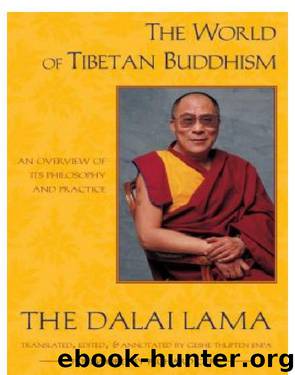The World of Tibetan Buddhism by The Dalai Lama

Author:The Dalai Lama
Language: eng
Format: azw3, epub
Publisher: Wisdom Publications
Published: 2010-07-26T03:00:00+00:00
17
PLEDGES AND VOWS
ONCE YOU HAVE TAKEN AN EMPOWERMENT, you have a great responsibility—a heavy burden!—to observe certain pledges and vows. In the first two classes of tantra, Action and Performance Tantra, though one must observe the bodhisattva vows, there is no need to take the tantric vows. In any tantra where there is a vajra master initiation, however, it becomes necessary to observe the tantric vows.
If one is emphasizing the practice of the three lower tantras, it is crucial to maintain a vegetarian diet. Vegetarianism is very admirable. In the case of those living in Tibet in the past, because of the climatic conditions and the scarcity of green vegetables, it is perhaps understandable that people generally adopted a non-vegetarian diet. Now, however, particularly in countries where there is an abundance of fresh vegetables and fruits, it is far better to reduce our consumption of non-vegetarian food as much as possible. Especially if you are entertaining a large gathering of people at festivals or parties, it is very good if you can arrange for vegetarian dishes to be served at such social occasions. There is a Tibetan story: Once, a nomad came to visit Lhasa, where he saw people eating a lot of vegetables. He was so surprised that when he returned home, he commented that one should never fear that the people of Lhasa would die of starvation—they eat anything that is green!
The general Buddhist stand on the question of vegetarianism, even from the perspective of the Vinaya, is that, apart from a few specific situations, there is no unequivocal prohibition against eating meat. This is the prevailing view in such Buddhist countries as Sri Lanka, Burma, and Thailand, as reflected in the dietary habits of the Buddhist monks from these countries. However, in the scriptural collections of the Mahayana—the Bodhisattva Vehicle—taking non-vegetarian food is generally proscribed. Yet, although there is this general proscription, it is not always followed strictly. We find that in his Madhyamaka-hṛdayakārikā (Essence of the Middle Way),55 Bhāvaviveka raises the question of vegetarianism and its importance for the Buddhist way of life. He reasons that since at the time of actually taking the food the animal has already died, the act of eating it does not constitute any direct harm to a sentient being. What is specifically prohibited is taking any meat or non-vegetarian food that you have ordered having the knowledge, or even the suspicion, that it has been killed especially for you. Such meat should not be eaten.
In the three lower classes of tantra, taking non-vegetarian food is strictly prohibited. In Highest Yoga Tantra, however, practitioners are actually advised to rely upon the five types of meat and the five types of nectar.56 The perfect practitioner of Highest Yoga Tantra is an individual of such high faculties that, through the power of meditative concentration, he or she is able to transform the five meats and the five nectars into purified substances, thus rendering them usable to increase the fuel of blissful energy within the body.
Download
The World of Tibetan Buddhism by The Dalai Lama.epub
This site does not store any files on its server. We only index and link to content provided by other sites. Please contact the content providers to delete copyright contents if any and email us, we'll remove relevant links or contents immediately.
The Way of Zen by Alan W. Watts(6292)
Ego Is the Enemy by Ryan Holiday(4964)
The Art of Happiness by The Dalai Lama(3851)
The Book of Joy by Dalai Lama(3709)
Why Buddhism is True by Robert Wright(3291)
Spark Joy by Marie Kondo(3091)
Shift into Freedom by Loch Kelly(3032)
Happiness by Matthieu Ricard(2890)
A Monk's Guide to a Clean House and Mind by Shoukei Matsumoto(2787)
The Lost Art of Good Conversation by Sakyong Mipham(2444)
The Meaning of the Library by unknow(2395)
The Third Eye by T. Lobsang Rampa(2174)
The Unfettered Mind: Writings from a Zen Master to a Master Swordsman by Takuan Soho(2160)
Red Shambhala by Andrei Znamenski(2074)
Anthology by T J(2049)
The Diamond Cutter by Geshe Michael Roach(1957)
Thoughts Without A Thinker: Psychotherapy from a Buddhist Perspective by Epstein Mark(1901)
Advice Not Given by Mark Epstein(1767)
Twilight of Idols and Anti-Christ by Friedrich Nietzsche(1764)
